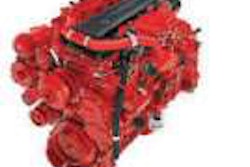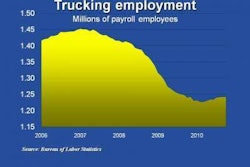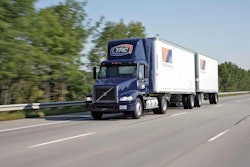All working together
Every wheel on a rig should be aligned, experts say
Alignment experts believe it’s critical to align the entire truck or rig, and not just set the toe and check the camber on the front axle. Up to 70 percent of steer tire irregular wear comes from improper alignment of the drive axles. “Just ask yourself which end of the tractor is in charge,” says Mike Beckett, president of MD Alignment. The front tires carry 12,000 pounds, while the rear tires handle 34,000 pounds – plus they have all the horsepower. “If you have a pull to the right, align the drive axles,” Beckett says.
 Hunter’s WinAlign alignment systems feature real-time monitoring of live vehicle measurements and viewing of vehicle-specific adjustment illustrations and digital images.
Hunter’s WinAlign alignment systems feature real-time monitoring of live vehicle measurements and viewing of vehicle-specific adjustment illustrations and digital images.MD’s portable Protrak alignment system – which doesn’t require racks, pits or turnplates – can accommodate wheels ranging from 16 to 24½ inches, and can be used on vehicles with wheels up to 445/95/25. The laser-based system can measure an axle in 6 minutes and is designed for any trailer configuration without any additional equipment. “You don’t have to jack the vehicle up and let it down,” Beckett says.
Bee-Line’s systems provide two alignment methods. The company’s portable “tune-up” system provides front toe and rear tracking on the shop floor, while its full-service system uses a platform and allows camber correction of the front axle. “It depends on how far you want to go,” says Mike McCoy, national account sales manager. “Even a tune-up, which is typical of what truckstops do, will increase tire mileage dramatically. Full service with axle correction like the most successful large fleets do will save more fuel dollars.”
When a trailer is “dog tracking,” it takes more horsepower to pull the rig. Preventive alignment can provide 30 percent more tire miles and 2 percent better fuel economy.
Hunter Engineering’s heavy-duty alignment system can be used in any available shop bay. The actual measurement equipment is not dependent upon anything other than a level floor. “Many of our systems are being used in mobile alignment service environments where the alignment is performed onsite at the customer’s shop,” says Greg Brock, heavy-duty training instructor.
Fleets will see improved tire life and fuel economy.
Hunter also offers PT, PF and PE pit systems with varying pit depths and weight capacities, as well as the RKHD surface-mount drive-on rack designed for alignments on trucks of all weight classes; it also can be installed as a flush-mount in a shallow pit from 24 to 30 inches deep. Its modular design allows it to be configured in any length, and trailer alignments can be performed on any level surface inside or outside.
The Bee-Line system can be used as a simple mechanical device where the technician makes adjustments as necessary to aim a laser at its target, or for full computerization; the rear axles are done by a separate system. All information can be fed into a computer to provide a printout of all alignment measurements, both before and after the work is done.
All alignment specifications contained in a Hunter system are supplied by the OEM, meaning the service provider will have the factory-preferred alignment values. “This is extremely useful when any warranty work is performed,” Brock says. The technician is guided through the alignment software program by intuitive instructions and procedures and is provided with step-by-step technical specifications and graphics.
Fleets should find an alignment system supplier that will continue to provide assistance after the sale is made and after technicians initially are trained on the equipment. Beckett and McCoy both recommend TMC RP 618 specifications, which are tighter than OEM specifications. n










